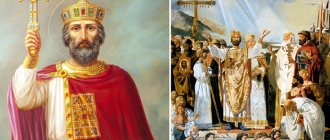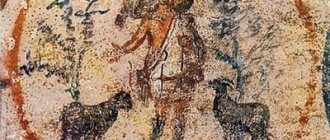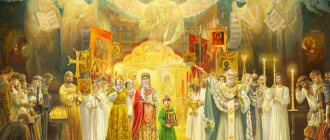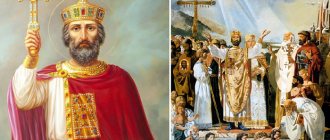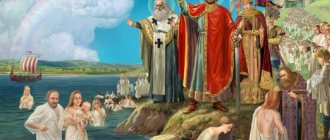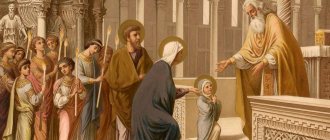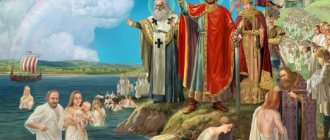Baptism of Rus'. The adoption of Christianity as the state religion at the end of the 10th century. Kyiv Prince Vladimir Svyatoslavich. The traditional date of the event is 988.
A number of authors also understand the term as the process of the spread of Christianity in Rus' in the 11th-12th centuries.
With a broad understanding of the term, the main stages of the baptism of Russia can be considered: 1) the so-called. the first (Photius or Askold) baptism in the 860s, which is usually associated with the names of the Kyiv princes Askold and Dir; it was accompanied by the creation of a bishopric (or archbishopric) in Rus', which later died;
2) personal baptism of the Kyiv princess Olga in Constantinople in 946 or 957;
3) the baptism of Rus' by Vladimir;
4) active church construction and measures to organize the Church, expand the diocesan and parish structures, taken under the Kiev prince. Yaroslav Vladimirovich the Wise and under his successors.
At what year?
According to the chronicle, Vladimir himself was baptized in 988.
In the same year, 988, a long process of acceptance of the faith by the Eastern Slavs began - but its final “point”, when Rus' truly became “Holy”, Orthodox, is difficult to determine.
Did it emerge Christian , having been tested, like gold in a crucible, from the timelessness of Mongol rule? Should we consider the existence of Christian Rus' since the 14th century, when St. Sergius of Radonezh? Or maybe from the 16th century, when the word “peasant” first appeared, what does “Christian” mean? Is this what rural producers call themselves, putting faith rather than their work at the forefront? The issue has definitely not been resolved to this day.
Is the exact date of the event known?
No. History has not preserved the day or month.
Where did the priests and other clergy come from?
Baptism of Princess Olga in Constantinople. Sketch by Ivan Akimov. 1792 State Russian Museum
The first clerics Cleric is the general name for clergy or clergy. began to appear in Kyiv and, probably, in other cities of Rus' long before 988. As we already wrote above, Princess Olga was baptized in Constantinople, and the Byzantine sources reporting this mention that she had a priest with her, who, apparently, stayed with her in Kyiv. According to the chronicle, Vladimir brought some clergy with him from Chersonesos. Some clergy probably arrived with the metropolitan, who came to Kyiv within a few years after the Epiphany. Later, the clergy were recruited from the local population. The chronicle speaks about this, albeit in the form of legends, in the news about the “book teaching” (meaning that “teaching” is necessary for worship) of the children of the “deliberate child”, that is, the children of the “best people”. The Tale of Bygone Years. St. Petersburg, 1996. .
What kind of faith was there before Baptism?
It is defined as the so-called pagan, from the Slavic “language”, or “people”. This suggests that the faith of the Slavs was determined by a kind of collective experience of understanding the world and nature. Very little data has been preserved about the paganism of Rus'. They are given:
- data from ethnographers, back at the beginning of the 20th century. who observed some rituals dating back to paganism; elements of a long-gone faith preserve the traditions of embroidery patterns and features of Slavic clothing;
- research by folklorists who wrote down not only songs, riddles, proverbs, but also many fairy tales containing elements of the pagan Slavic worldview;
- finally, Russian chronicles report some names of Slavic gods and some details about rituals.
The main features of religion include:
- polytheism;
- magic, when the basis of interaction with nature, spirits, and gods are various types of magical practices.
When did Christianity appear in Rus'?
It is known that the Christianization of Europe began already in the 1st century, and the Slavs came to the East European Plain from this region. With a high probability we can say that faith was at least known to them. Russian chronicles indicate that at least from the 9th century. Among the princely warriors there were many Christians. It is traditionally believed that they were also the Kiev princes Askold and Dir (late 9th century)
Askold and Dir in Constantinople (chronicle miniature)
A new stage in the spread of faith begins under Princess Olga, who is the first of the Russian princesses to receive the Sacrament from the hand of the Patriarch of Constantinople. However, the Christianization of Russia under the princess is hampered by both the position of the majority of the population and the desire of Byzantium, where the princess more than once turned with a request to form a diocese and send priests. The empire had in mind political benefits from the Christianization of such a large territory and wanted to gain control over trade routes.
And everyone started wearing crosses?
The pendant cross is one-sided. Veliky Novgorod, late 11th century Institute of Archeology RAS
Yes, after baptism, many actually began to wear crosses. In the graves of the 11th century, burials in which were performed according to Christian rites, the dead, as a rule, lie with crosses. In chronicles and other texts of the late 11th - 12th centuries, the custom of wearing a pectoral cross is already mentioned as a matter of course and universal.
Why Princess Olga failed to instill faith in her son Svyatoslav
First of all, because at the time of the spiritual rebirth of the pagan princess, who became a Christian, he was an adult, an established personality. At the same time, the prince:
- had state views that were different from those of his mother: while Olga cared about the spiritual unity of the country, Svyatoslav was more interested in conquering new territories, controlling trade, and making a profit;
- like any prince, he was heavily dependent on his squad, most of which were pagan; Svyatoslav seriously feared that internal conflicts would not give him the opportunity to continue effective military campaigns.
For these reasons, respecting his mother’s beliefs, the prince did not share them, remaining an adherent of paganism until the end of his days. At the same time, the chronicler, speaking about Svyatoslav, does not utter a word of condemnation; on the contrary, he admires his military talents, courage, and honesty: of course, in his own way he was an integral, sincere person who was just as sincerely mistaken. However, Svyatoslav apparently never forbade his mother to raise his children – Olga’s grandchildren – Christianly.
“Olga’s Baptism” – art. S. A. Kirillov, 1993
Reasons for accepting Christianity
The main events that took place in Byzantium contributed to the adoption of Christianity in Rus'. The Byzantine Empire was going through difficult times in the late 90s of the 10th century. Emperor Vasily II needed help to suppress the rebellion, and he decided to turn to the Kyiv prince Vladimir. To which the prince agreed, but on condition of marriage with the emperor’s sister, Princess Anna.
A mandatory condition on the part of the emperor was the prince's acceptance of Christianity. In 988, Prince Vladimir and his retinue were baptized in Chersonesos, and only after that the wedding with Princess Anna took place.
Vladimir, having returned to Kyiv, turned to the people of Kiev with an offer to be baptized. This happened in 988, so this year of baptism is celebrated as the adoption of Christianity in Rus'.
There are other reasons that contribute to the adoption of Christianity. These include:
- the urgent need for the formation of a unified ideology in the state, which would spiritually unite the diverse peoples of Rus';
- strengthening ties with the peoples of Western countries;
- achieving a stable position for Rus';
- strengthening the power of Prince Vladimir;
- becoming an ally of Byzantium.
The choice of the Kyiv prince Vladimir fell on Christianity because there were contradictions in Islam to the established way of life, such as the ban on drinking wine, pork, as well as specific Eastern rituals (circumcision, horse slaughter).
Since Prince Vladimir set himself the goal of strengthening his power, he had no sympathy for Catholicism. Indeed, in Byzantium, the Orthodox Church in those years was politically helpless and completely subordinate to the emperors.
Even more prohibitions appeared in Judaism.
The Christian religion called for tolerance and forgiveness, it did not require sacrifices, did not divide peoples by nationality, and therefore the Russian prince chose Orthodoxy.
Why did Prince Vladimir decide to accept Baptism
It is known that initially he did not have such intentions: fighting for the grand-ducal throne with his brothers, the prince appealed to the “fatherly faith.” Later his position changes.
List the main reasons
These include, first of all, political ones:
- most of the European states (including the Slavic countries culturally close to Rus' - Bulgaria, Moravia, etc.) had adopted Christianity by this time; military, economic, and political contacts were greatly hampered due to the confessional factor;
- Vladimir could not help but see that paganism, based on the veneration of tribal deities, was politically dividing the country; a common spiritual basis was needed; the prince’s attempt to forcibly establish the cult of the god of warriors Perun completely failed: the population simply did not accept this “reform”;
- finally, having a territory, as well as an economic potential comparable to Byzantium, Russia, since the time of Olga, had well-defined great-power ambitions, which were hindered by... Russia itself, spiritually divided, torn apart by tribal strife, while Christian Byzantium was at that time the only world power ; the choice of faith seemed quite obvious.
In addition to these, Vladimir also had personal motives. Perhaps it:
- the sacredly preserved memory of Olga, for whom the respect of the elite and the people was extremely great;
- the presence of Christians within the squad of the prince himself; many suggest that he was especially shocked by the death of the best warriors, the Varangians Theodore and John , who preferred death to participation in sacrifice to demonic forces, as Christians called “gods”;
“The first Christian martyrs under St. Vladimir” Painting by Pavel Sorokin. 1852, 1852 Canvas, oil. Size: 179.5 x 225 cm. Tretyakov Gallery
- finally, the personal appeal of Vladimir himself is shrouded in secrecy; the chronicler describes this, saying that the prince suddenly lost his sight on the eve of the Sacrament, and regained his sight in the font; This is a metaphor, or we are talking about a real miracle, but the prince’s personality after accepting the faith changed beyond recognition.
The prince who baptized Rus'
Here is the prayer of Prince Vladimir at the Baptism of the Kievites, and yet he could then be considered only a novice:
“God, who created heaven and earth! Look at this new people, and let them lead you, the true God, as you led the countries of the peasants, and establish in them a faith that is right and incorruptible, and help me, Lord, against the opposing enemy, so that, trusting in you and in your power, I will escape the intrigues his".
Why was Rus' baptized?
The prince believed that the new faith provided the foundation for the future spiritual unity of the Russians. That is why he did not limit himself to the personal acceptance of Christianity , but was actively involved in educating not only the political elite, but the entire population.
Paganism of Ancient Rus'
Before the adoption of Christianity, the Slavs were pagans. Each tribe worshiped its own god, who was considered its protector and patron. Common Slavic deities also stood out. The most significant in Ancient Rus' were:
- Perun (god of thunder, lightning and thunder, later patron of warriors);
- Volos or Veles (god of livestock, trade and wealth);
- Dazhdbog and Khors (various incarnations of the sun god);
- Stribog (god of the winds, whirlwind and blizzard);
- Mokosh (goddess of earth and fertility);
- Simargl (god of seeds and crops).
As princely power strengthened, the need arose to centralize the state. The diversity of pagan beliefs weakened Ancient Rus' and prevented the merging of tribes into a single ethnic group.
The first attempt to create a national religion was made during the reign of Vladimir Svyatoslavovich. After defeating all opponents and establishing himself on the grand-ducal throne, Vladimir ordered the installation of idols of the main Slavic gods, the so-called pantheon of gods, in Kyiv.
Rice. 1. Reconstruction of the temple of Perun on the island of Peryn.
At the head of the pantheon stood the wooden Perun with a silver head and a golden mustache. The people of Kiev offered sacrifices to the deities, including human ones.
Where did the first baptism of the people take place?
Obviously, this happened immediately upon the prince’s return to Kyiv from Chersonese (Korsun), where he himself was baptized. The chronicler indicates that after this the ruler called on all residents of the capital of Rus' to accept the faith. The sacrament took place en masse, but there are different opinions about its place:
- on the Pochaina River - a tributary of the Dnieper, which has now practically disappeared from the map of the city. On the site of the former river there is Naberezhno-Khreshchatytskaya Street;
- directly on the Dnieper.
Both versions contain different lists of the Tale of Bygone Years, which perhaps suggests that there could be several places. The chronicling process itself is described as completely voluntary.
“The Baptism of Rus'” - fresco by artist V.M. Vasnetsov in the Vladimir Cathedral in Kyiv, 1896.
What would have happened if Rus' had not been baptized? Would we remain pagans?
The reign of Vladimir Svyatoslavich in Kyiv; the erection, at his command, of wooden figures of the god Perun and other pagan deities on the hill. Miniature from the Radziwill Chronicle. Late 15th century Library of the Academy of Sciences in St. Petersburg
Probably, for some time paganism could exist in Russia as the main cult. In any case, it is known that in neighboring Poland, after the adoption of Christianity at the end of the 10th - beginning of the 11th century, a period of pagan reaction began (it was expressed in a series of uprisings against the ruling Piast dynasty in the 1030s), and in more distant Scandinavia Christianity remained for a long time ( until the end of the 12th century) gained ground. But paganism was doomed to disappear. There is an example of some West Slavic tribes (Polabian Slavs - Obodrits, Lutichs and others), who, in the face of German aggression in the 10th-12th centuries, acting under the slogans of baptism, “mothballed” their pagan beliefs. For some time, this conservation helped them defend their original culture and political independence, but by the end of the 12th century they lost their independence and became part of the German states. But those Slavs who adopted Christianity were just able to defend their independence.
How all of Rus' was baptized
Apparently, during the Christianization of the country, things could not be done without the confrontation between paganism and the new faith. For example, it is known that:
- the inhabitants of Murom categorically did not accept Prince Gleb, the son of Vladimir, who tried to establish Christianity here; he was forced to establish a residence outside the city walls;
- The Vyatichi killed the missionary monk St. Kuksha from the Kiev-Pechersk monastery;
- The Drevlyans, neighbors of the Polyans (on whose territory Kyiv was located), were the last to accept the faith - they could not forget how Princess Olga, while still a pagan, cruelly took revenge on them for the death of her husband, Igor.
But only one case of truly violent “baptism by fire and sword” was recorded - this was Novgorod, where, however, there were serious political reasons for open rebellion - opposition to Kyiv as the leader of the country, in addition, hostility towards Vladimir personally. Mass forced conversion of Russians should be considered extremely unlikely: the then grand ducal power was too weak for this.
Ilya Glazunov. "Baptism of Novgorod"
Cultural and political implications
Rus' accepted Baptism before the schism of the Eastern and Western Churches occurred (in 1054), but it was already in the ripening stage and was expressed both in doctrine and in relation to the church and secular power.
In Byzantium, church and state legal consciousness meant the emperor as the guardian and supreme defender of the Church (epistimonarch). Thus, he was considered the sole autocrat (autocrator) of the entire Orthodox people. He gave the titles of princes, archons, and stolniks to the rulers of other Christian states.
Consequently, Vladimir, after Kievan Rus adopted the Christian faith from the Byzantines, automatically introduced his country into the structure of the Byzantine state.
In the 12th century, the great prince of Kyiv in Constantinople was given the title of steward by the Byzantine emperor. The place of the Kyiv Metropolis in the diptychs of Constantinople was one of the last, initially - 61st, in subsequent years (1306-1328) - 77th place.
The adoption of Christianity also had cultural consequences, this was expressed in the development (in the forms of the Middle Ages) of architecture and painting, the penetration of Byzantine culture, which is the heir to ancient traditions.
Particularly important was the development of Cyrillic writing and the appearance of books. Actually, the baptism of Rus' contributed to the appearance of the first monuments of ancient Russian writing.
How did the population accept the new faith?
Data on this are scarce and therefore very contradictory:
- on the one hand, it is obvious not only resistance to Christianity, but also a shallow understanding of it: for example, pagan customs were preserved for a long time, and Russian princes until the 13th century. at birth they received two names - Christian and pagan (for example, even the names of St. Boris and Gleb are pagan, and they were baptized as Roman and David);
- on the other hand, the first decades of Christianization became a time of such a rise in spiritual life that it even caused some bewilderment among the Byzantines: the Kiev Pechersky Monastery appeared, without exaggeration, the spiritual heart of the country, and in Kiev alone there were up to 1000 churches; finally, within a few decades, the young Church received its first saints, moreover, martyrs for the faith - these are the same saints. Boris and Gleb, who chose to die rather than participate in the fratricidal civil strife.
Therefore, we can say that the spiritual rebirth of the country took place, perhaps not quickly, but thoroughly. An indicator of this is the fate of Slavic paganism, about which so little is now known.
Kiev-Pechersk Lavra, Kyiv
As a functioning, integral religion, paganism apparently ceased to exist by the end of the 13th century, if not earlier. And the attempts of modern neo-pagan movements to “revive” the “faith of our ancestors” from the point of view of most professionals are not even historical reconstruction, because there is almost no material for it. They blame, of course, Prince Vladimir, who allegedly forcibly baptized Rus'.
The truth is much more unpleasant for opponents of Christianity: no violence can compare with the kind of “self-censorship” of the Russians: accepting the faith, albeit not immediately, not at once, they so decisively abandoned their previous errors that after several generations it was time to collect the fragments of the “fatherly faith” - But Christians didn’t need it...
Why was Prince Vladimir called the Red Sun?
A prince with such a nickname is a hero of epics. Experts believe that this is “not quite” St. Vladimir: Rather, “Red Sun” is a collective image. Here, in the popular consciousness, two Vladimirs merged - the Holy Baptist with the one who lived at the beginning of the 12th century. Monomakh.
Monument to Prince Vladimir in Kyiv
Vladimir Monomakh
This is a prince whose name was a true legend in Rus' at that time, and his military talent, personal decency, and deep faith gained the prince such authority that his personality alone ensured the almost monolithic unity of the country. Vladimir is the son of the youngest son of Yaroslav the Wise, Vsevolod, married to a Byzantine princess from the Monomakh family - hence the nickname. The prince immortalized his name thanks to:
- many years of successful resistance to the nomadic Cumans;
- wise management of Kiev, where he began to reign when he was already 60 years old (from 1113).
It is believed that Monomakh is the creator of perhaps the first “social legislation”, “Russian Truth of Vladimir Monomakh”, which contains a number of articles limiting the arbitrariness of money lenders, for example, interest on loans issued.
Interesting fact
The ruler is also known as the author of the “Instruction”, instructions for children, written by a true patriot of the country, and at the same time a true Christian. Monomakh died near the place of his death. Prince Boris - here, to the place associated with the revered saint, he came, feeling the approach of death.
Thus, this ruler is a living testimony to the Christianization of the country, which began under Saint Vladimir, and less than 200 years later gave rise to princes with a completely different, Christian state mentality. The two images merged together, of course, not by chance.
After that, did they immediately start building churches and painting icons?
The consecration of the Mother of God (Tithe) Church in Kyiv, built by order of Vladimir Svyatoslavich by Greek craftsmen and decorated with icons and utensils from Korsun, and the appointment of Anastas and other Korsun priests as ministers in it. Miniature from the Radziwill Chronicle. End of the 15th century Library of the Academy of Sciences in St. Petersburg
The chronicle reports that after mass baptism in Kiev, by order and at the expense of the prince, they began to “set up churches and priests throughout the city” The Tale of Bygone Years. St. Petersburg, 1996.. It specifically talks about the construction of the Tithe Church of the Virgin Mary in the city. It began to be called tithe because a tenth of the prince’s income was allocated to support it. The church was a very representative building; it was decorated with mosaics and frescoes. It was severely damaged during the capture of the city by the Mongols at the end of 1240, and then gradually collapsed until the 20th century. Archaeologists discovered its foundation (which can still be seen today) and confirmed that the church was built at the end of the 10th century. It is known that after the death of Vladimir in 1015, there were already hundreds of churches in the city: in addition to the Tithe Church, the then wooden St. Sophia Cathedral and other large churches, numerous small private churches and chapels were also built. Obviously, they must have had some kind of icons, but the oldest surviving icons of pre-Mongol Rus' date back to no earlier than the middle of the 11th century.
Historical significance of the baptism of Rus'
It comes down not only to the fact that temples and worship became an integral part of culture, and writing appeared, created by Sts. Cyril and Methodius . Gradually, Christianity permeated all spheres of the country’s life and began to determine its value system. In many ways, it still continues.
Although the number of people leading church life is now small, still more than half of the Russian population, even after 70 years of state atheism, define themselves as “Orthodox.” And this is much more than at the time when the first missionaries appeared in pagan Rus'. However, the “second Baptism of Rus',” as the modern period is called, is, of course, not much easier than the first.
Natalia Sazonova
Baptism ceremony
By the will of Prince Vladimir, on July 28, 988, the population of Kyiv was gathered on the banks of the Dnieper for baptism in its waters. Who baptized Kievan Rus? The ceremony was carried out by Byzantine priests, specially invited for this purpose. Now this date is celebrated as the official holiday of the baptism of Rus'.
Vladimir began baptism with his sons and his close associates. Then he ordered all the idols to be destroyed, and Perun (the main idol) to be thrown into the Dnieper.
On a certain day, Kyivans were baptized en masse in the Pochayna River, at the place where it flowed into the Dnieper.
From this date, the spread of Christianity began, which lasted for several centuries. The reason for this was paganism; it remained very strong in many principalities. Many divisions had to be overcome before the Orthodox faith was fully established as the official religion.
So in 1024 in the Vladimir-Suzdal principality there was a rebellion of supporters of the old faith, and in 1071 the uprising in Novgorod was suppressed. Rostov adopted Christianity only towards the end of the 11th century, and Murom even later, closer to the 12th century.
